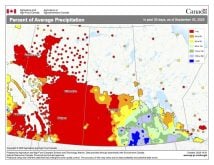By the time you read this it will be February, time for the first monthly weather review of 2023, but I find myself a little stuck. As I write this, there are still five days left in January and with a cold snap settling into our region, I cannot do a monthly review with that many days left.
We will wait one more week for the look back and then take our usual look ahead to see what the latest forecasts say for the final two months of winter.
Periodically I look through past articles to make sure I don’t repeat topics too often. Over the last 19 years, I noticed that every three or so years, I go back to my weather school articles.
Read Also

Farmer gift idea: How about a weather station?
The 2025 holiday season is looming, and a home weather station might make a great Christmas gift for farmers
These are a series of articles that basically take you through the topics in a first-year meteorology class, where instead of reading up on the different topics, I try to distill the main points and present it in an easy way. The bonus is that you do not have to study, take any tests, or pay for a university course!
I find that going through these articles helps reinforce my understanding and allows me to rewrite them, hopefully making them better, which is a good teaching practice.
To begin our understanding of how and why we have weather on Earth, we need to go to the source of almost all our energy: the sun.
Our sun is an average star, as far as stars go, and is estimated to be about halfway through its expected lifespan of around 12 billion years. While our sun is on the small side compared to other stars, it comprises about 99 per cent of all the matter in our solar system – the rest being made up of the planets, moons, asteroids, comets and any other debris.
Most of the matter in our sun is hydrogen, the simplest and most abundant element in the universe. Inside the sun, the pressure of all the hydrogen causes the temperature to rise, and when it is hot enough, the hydrogen starts to fuse into helium. This also produces energy in the form of heat.
This nuclear fusion reaction has been going on in our sun for billions of years and there is enough hydrogen for it to continue for billions of years more, so no need to worry.
Not surprisingly, since our sun is a boring smallish star, the fusion of hydrogen into helium has been occurring at a remarkably stable rate and should continue being relatively stable for a very long time. While there appear to be slight changes in the amount of energy produced by our sun over time, they are tiny when compared to the overall energy output.
The sun provides Earth with nearly all our heat energy. How does this energy reach Earth? After all, isn’t space an icy cold vacuum? The answer is radiation, or more specifically, electromagnetic radiation.
Wavelengths
The first thing that comes to most peoples’ minds when they hear the term radiation is probably nuclear bombs or some kind of dangerous invisible ray that will give you cancer.
But there are many different kinds of radiation; some of them harmful to humans (organic life) and others are not. To really understand this, we need to look at the electromagnetic spectrum.
If you look at an image of this spectrum, you would quickly notice that several everyday forms of energy are part of it. On the low end of the spectrum, we have radio and TV waves and near the middle we have visible light. That’s right, visible light – the energy that allows us to see things is a form of radiation. At the top end of the spectrum are harmful forms of radiation such as X-rays and gamma rays.
These different forms of radiation are simply waves of energy, and the size of their wavelengths is what determines how much energy they have. Long wavelengths, like radio waves (around one metre in length), have very low energy levels. After all, they are all around us and no one really seems affected by them.
As the wavelengths become smaller, we move into infrared and then into the visible area of the spectrum. Light waves are around 400 to 700 billionths of a metre in size.
If you think about it, you might assume that most of the electromagnetic radiation coming from the sun would be in the form of high-energy waves like ultraviolet, X-ray or gamma rays, since our sun is so hot. While our sun does emit all these different forms of electromagnetic radiation, most of it comes in the form of visible light.
The most interesting point about electromagnetic energy is that it can travel through the vacuum of space and arrive on Earth, where it is either reflected or absorbed and turned into a different form of energy: heat.
This leads us to our next topic for weather class: insolation and the solar constant. Before we dive in, we will look back at January’s weather numbers and look ahead at the forecasts for what will hopefully be the last two months of winter.
















